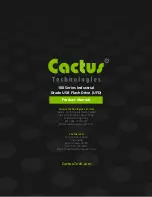
Creating Shares
Chapter 6 Share and File Access
87
example, if you enter ‘abc’ as your search criterion, all users and groups
containing ‘abc’ in the name will be identified.
Creating Shares
Shares are created, viewed, edited, and deleted from the
Storage > Shares
screen of
the Administration Tool. The default share (SHARE1) maps to the root of the
volume and grants access to all users and groups over all protocols.
Note
As a security measure, disable any protocols not required for your network
environment.
Guidelines
Consider the following guidelines when creating or deleting shares.
Maintain at Least One Share at the Root of Each Volume
A share to the root of a volume is recommended for backup purposes. Security for
any share at the root of the volume should be given special consideration. Any user
or group that has access to the root of a volume will have access to EVERY file and
subdirectory on that volume unless there is a specific ACL in place precluding that
access. In general, access to a share at the root of a volume should only be granted to
a system administrator or backup operator.
Hidden Shares
A
hidden
share is hidden from clients connecting from the SMB, HTTP, AFP, and
FTP (but not NFS) protocols. For example, assume SHARE1 is set as hidden.
Windows users will not see the share when viewing the server through Network
Neighborhood, or when performing a
net view \\servername
on the Snap Server.
For more information, see “Configuring Share and Folder Security Overview” on
page 80.
Snapshot Shares
Note
Snapshot shares are only available if snapshots are licensed.
A
snapshot
share
provides access to all current snapshots of a volume. Just as a share
provides access to a portion of a live volume, a snapshot share provides access to
the same portion of the file system on any archived snapshots of the volume. You
create a snapshot share by selecting the
Create Snapshot Share
check box in the course
of creating or editing a share.
Summary of Contents for 5325301656 - Snap Server 14000 NAS
Page 2: ......
Page 76: ...Disks and Units 62 Snap Server Administrator Guide ...
Page 92: ...Creating iSCSI Disks 78 Snap Server Administrator Guide ...
Page 108: ...Security Guides 94 Snap Server Administrator Guide ...
Page 144: ...Unicode and Expansion Arrays 130 Snap Server Administrator Guide ...
Page 164: ...Off the Shelf Backup Solutions for the Snap Server 150 Snap Server Administrator Guide ...
Page 172: ...Scripts in SnapCLI 158 Snap Server Administrator Guide ...
















































